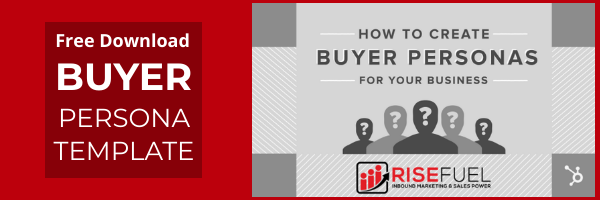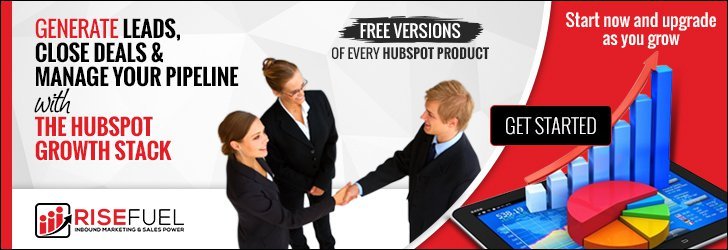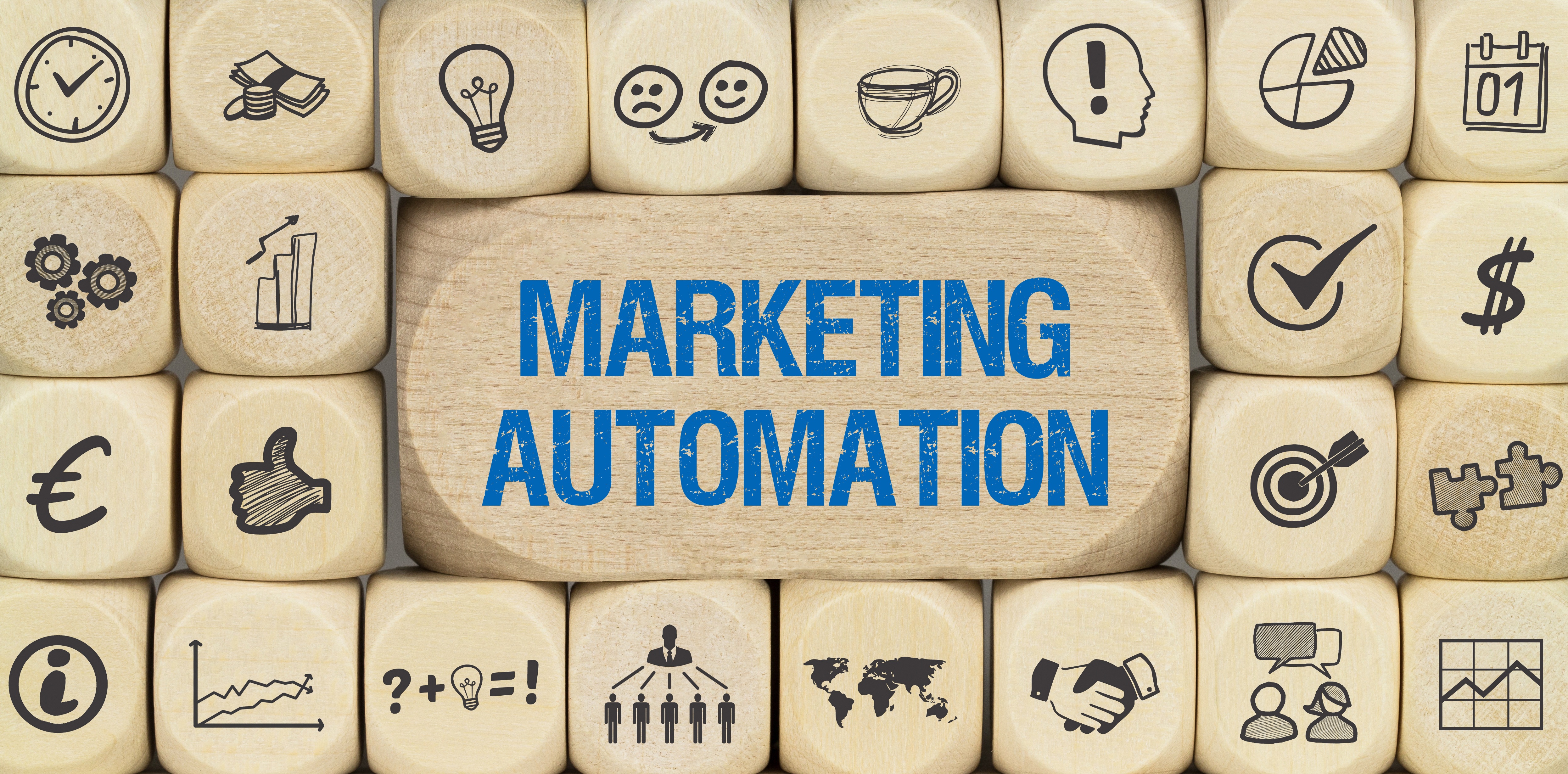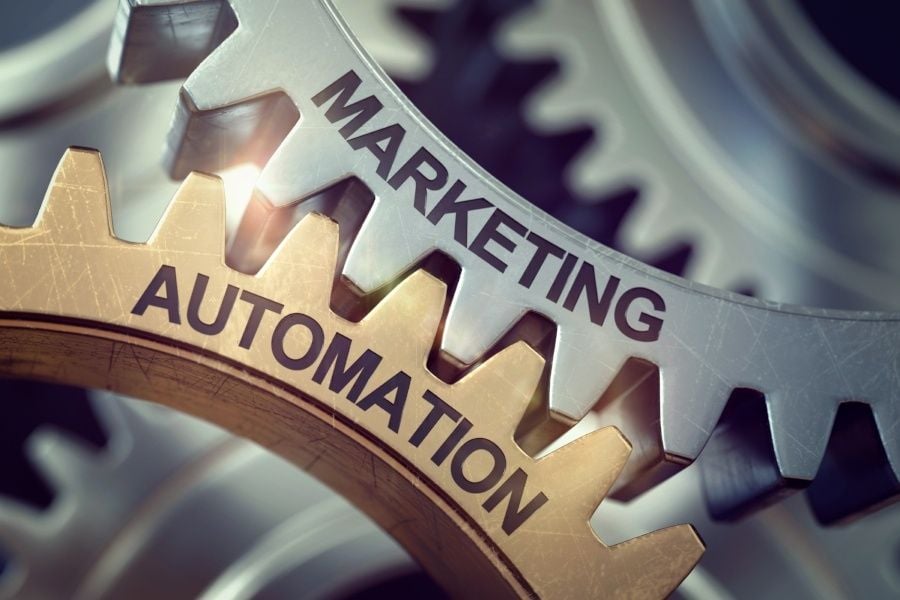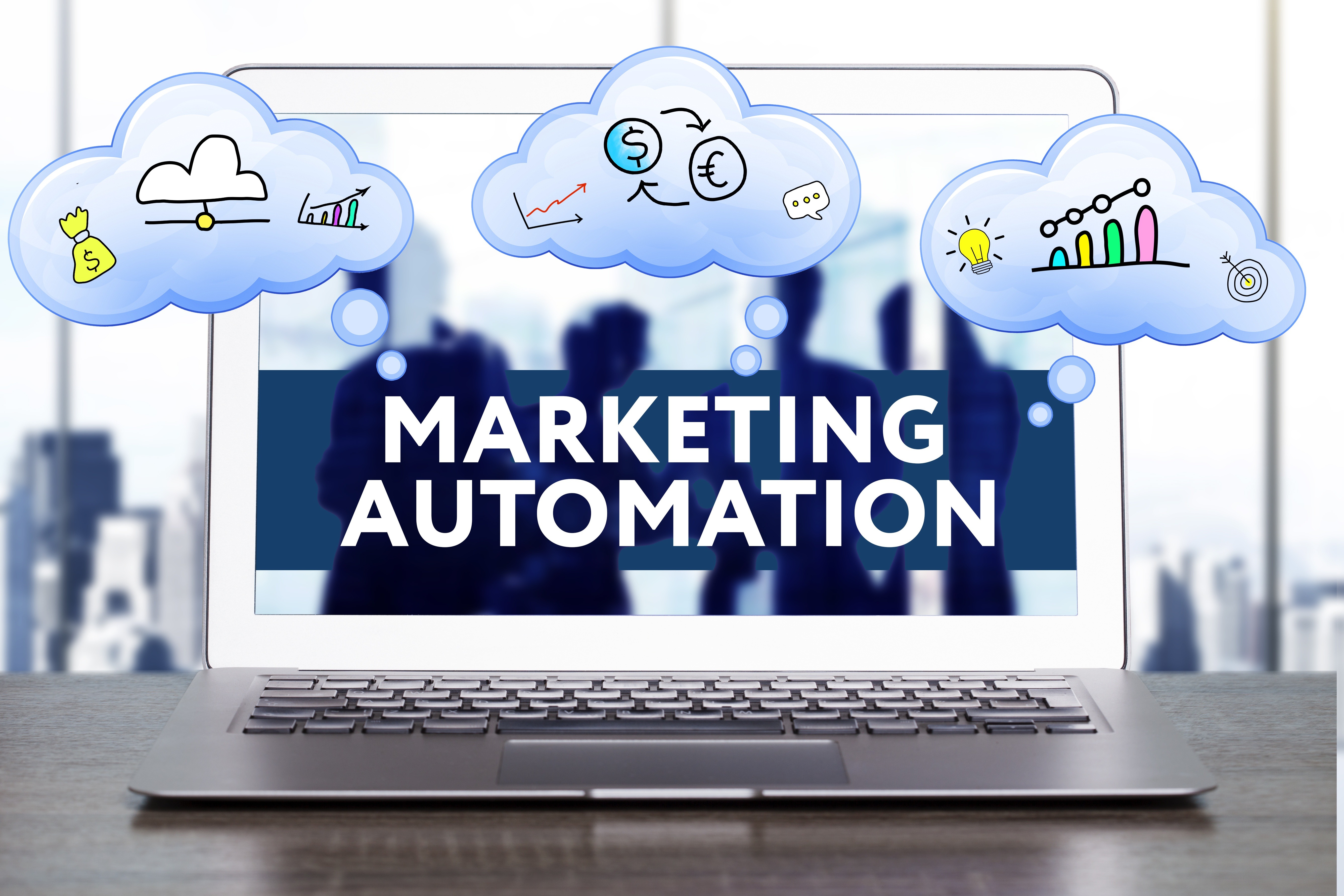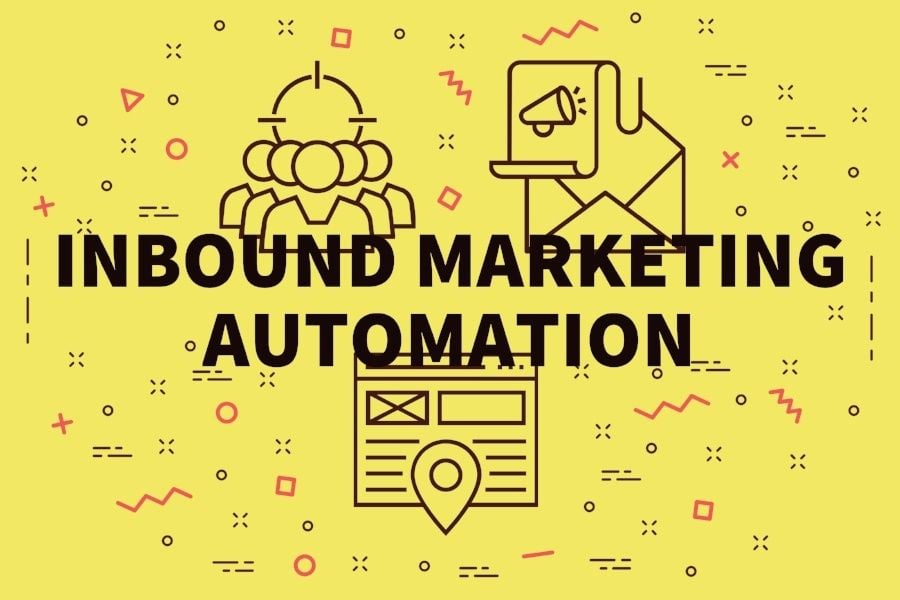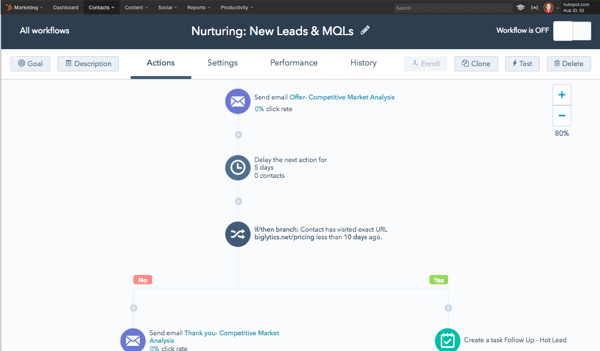
Marketing automation is the future. There is no doubt about it. Today, brands collect more data than ever. Collecting customer data allows them to better tailor marketing messages to their prospects and customers.
It creates a better experience for your customers, which is critical. 86% of buyers are willing to pay more for a great customer experience.
Today, marketing professionals rate “customer experience” as the most exciting business opportunity for their brand
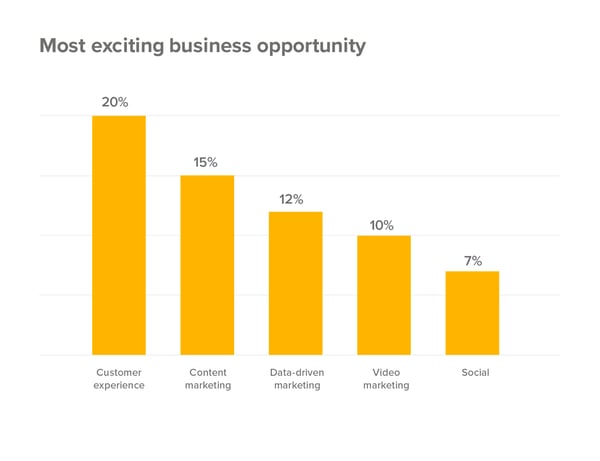
Source: SuperOffice
Here at RiseFuel, we use the HubSpot platform to design, create, and execute effective automation strategies for our clients. We find it to be the most effective platform for small and mid-sized businesses.
To understand why HubSpot marketing automation is so powerful, let’s start by covering what both HubSpot and marketing automation are.
What is HubSpot?
HubSpot dubs itself a “growth platform.” In short — they offer a monthly software subscription that delivers marketing, sales, and support tools to companies.
Their marketing products are designed to help companies create content, generate leads, and nurture them until they're qualified and sales-ready.
Their sales products are designed to help companies engage potential buyers, demonstrate the value of your offering, and close deals.
Their support products are designed to help companies Resolve customer issues to ensure success that generates positive word of mouth.
Embracing the inbound marketing philosophy, HubSpot is designed to be a complete customer relationship management system, helping companies to walk customers through the customer lifecycle and provide a better service and experience.
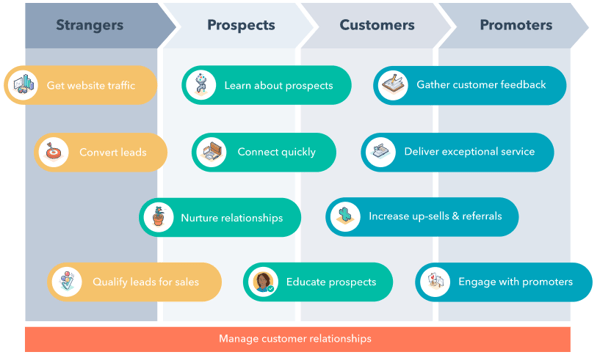
Source: HubSpot
While the sales and support platforms offered by HubSpot are growing rapidly, their Marketing suite is by far their most popular product.
In its early days, HubSpot focused exclusively on inbound marketing and did not offer full sales or support platforms to its customers.
Marketing automation is a complete system where all of your marketing activities presale and post-sale, work together to create a more seamless experience for your customers.
If you are interested in HubSpot, there is a good chance that what drew you to their product was the in-depth automation features.
What is Marketing Automation?
Inbound marketing lends itself well to marketing automation — particularly as it applies to digital marketing.
Marketing automation refers to the process of using software to automate marketing tasks and activities.
There are many different digital marketing tasks that can be automated, most of which are included in the Hubspot Marketing product suite.
These include content posting, email marketing, social media posting, and ad campaigns.
Marketing automation delivers many benefits:
- Marketing team efficiency. Automation helps teams to automate mundane and continuous tasks like data entry, sending messages, and injecting personalization into those messages.
- Improved personalization. HubSpot’s marketing automation tools use the HubSpot Customer Relationship Management tool to collect data on prospects and customers. Then, you can inject that data into marketing campaigns automatically. Any customer data that you collect can be used for personalization within the HubSpot platform.
- A better experience for customers. 80% of customers are more likely to purchase a product or service from a brand that provides a personalized experience.
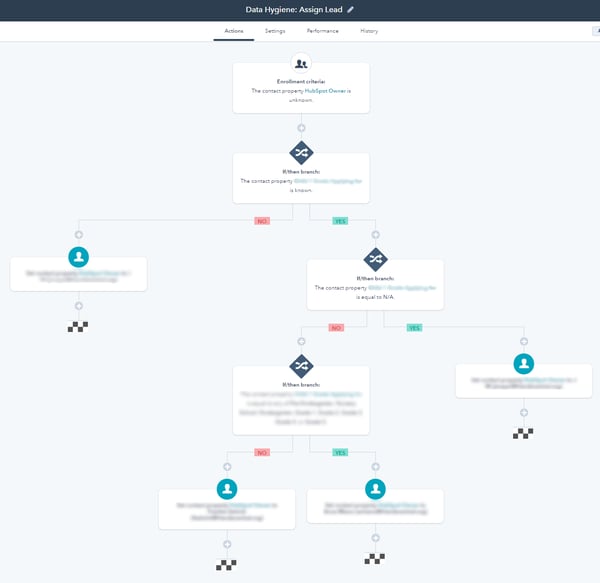
Automation is critical in modern marketing teams that are looking to scale. The ability to effectively deliver marketing messages to (potentially thousands) of customers is so critical and impossible by hand.
When all of the gears are working in unison, automation is an effective marriage between software and strategy.
It allows you to better understand your prospects, deliver marketing materials at precisely the right time in the customer lifecycle, and convert them into loyal customers.
Think of marketing automation as building a house. You need to lay the foundation of the home before you can begin building anything. You need to carefully plan and design the project.
Automation is the difference between using a hammer or a nail gun — both are capable of the same thing, but one is undoubtedly a quicker and better choice for the project. In building out your automation systems, over time, you’ll build a home.
Automation doesn’t end when your prospects buy your product, either. Automation should continue to play a critical role in how you engage with them throughout their time as your customer.
Even after they buy, you should be consistently delivering information about how to use your product, introduce them to other products (or upgrades), and continue the relationship-building process.
Customers aren’t an afterthought at the end of the funnel. Your understanding of them should be central to the strategies that you employ.
Successful marketing strategies make everything move faster and more effectively.
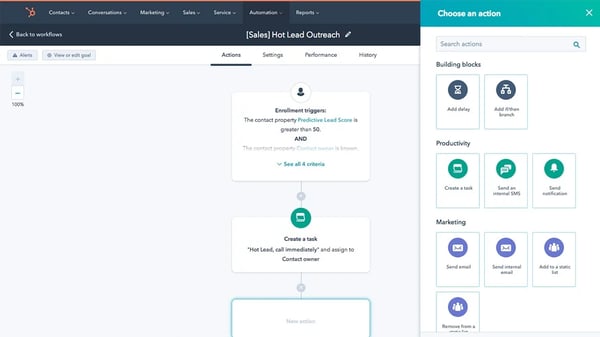
Prospects move through the funnel more quickly and convert at higher rates. Customers upgrade or are upsold faster and at higher rates.
In the end, this leads to better relationships with your customers and more brand advocacy on their part.
Marketing Automation Misconceptions
Before we dive into how marketing automation works on HubSpot, we want to dispel some of the common misconceptions that are associated with the practice.
Automation Means Less Focus on Strategy
Marketing automation is not a cure for bad marketing. Just because you can automate the messages that you send to your customers doesn’t mean that the strategies that you employ become any less important.
You still need a solid strategy and an understanding of your customers to speak to their biggest problems and deliver your messaging in a way that is will resonate with them.
If anything, marketing automation allows you to focus more on strategy and spend less time on the type of mundane marketing tasks that tend to slow you down.
Marketing Automation is Not the Cure for Growth
Marketing automation certainly makes executing marketing strategies easier for both teams and individuals. But automation is not a cure for slow growth, either.
Often, automation plays a critical role in helping you to nurture the leads that you generate but is not in itself a cure for slow lead generation.
The problem with this misconception is that it leaves many marketers with lots of tools to automate portions of the middle of their funnel and no real strategy for actually generating the leads.
Automation is a long-term solution, not a quick fix to your marketing strategy issues.
HubSpot Automation is Complicated
The truth is that your automation strategy can be as complicated or simple as you want it to be.
Yes, you can build in all sorts of actions and triggers that push customers down certain paths, and that can be effective.
However, when you are first starting out, it may be in your best interest to keep things simple. In the beginning, keep all customers in the same campaign.
Test how changes to your marketing automation strategies affect outcomes.
If you feel intimidated by the complexity of automation, rest assured that you can simplify your strategy as much as you’d like until you are comfortable.
HubSpot Marketing Software Workflows
The main tool within HubSpot for setting up and expanding automation are called “Workflows.” These workflows are the steps and sequences that HubSpot will execute based on a variety of triggers.
Those triggers could be simple — like signing up for your email list and triggering a string of automated marketing emails.
Or they could be more complicated — like viewing a specific blog post triggering a completely different string of emails, outside of your normal campaigns.
HubSpot marketing automation workflows work by tying together different aspects of their platform to create a consistent experience for all leads and customers in your system.
Let’s take a look at some of the things that you can do with HubSpot automation workflows:
Run Segmented Lead Nurturing Drip Campaigns
One of the most common and oft-cited channels for marketing automation is email. It’s simple to envision how an effective email sequence, delivered to interested prospects might help them to become familiar with your brand and develop trust over time.
HubSpot’s email nurturing drip campaigns can be used to push prospects down the funnel and help you to generate and identify more qualified leads within your pipeline.
One example of an innovative drip campaign is a re-engagement campaign for inactive prospects.
You could build a workflow to automatically segment leads based on when they last engaged with your brand, then deliver a re-engagement campaign to prospects that haven’t engaged with your brand for 60 days, for example.
Or you could send a specific personalized sequence to customers that have abandoned their cart with products in it.
The beauty of HubSpot’s system is that you don’t need to be all that technical to use it. You never have to write a line of code.
There are dozens of pre-defined triggers and conditions that you can choose from. You can also tie email workflows to specific goals.
A Visual System with HubSpot's Marketing Automation Platform
The HubSpot Workflow system is visual. You can see the exact paths that prospects will take based on the decision trees that you create.
Take this example:
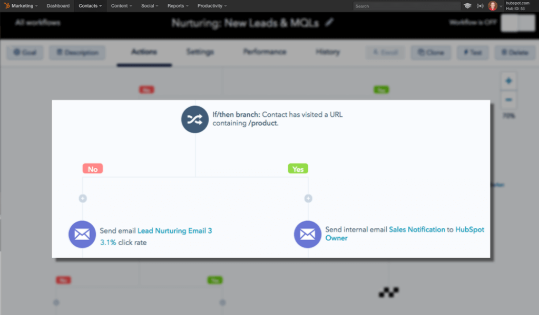 Source: HubSpot
Source: HubSpot
In this example, the trigger is whether or not a prospect has visited a specific URL that contains a product. If they have, they are sent down one track. If they haven’t, they are sent down another track.
A campaign might be made up of only a few trigger trees like this, or potentially dozens or even hundreds.
You can create simple follow-up campaigns or full customer journeys with multiple branches based on the actions that they take and the data that you are able to collect.
Their system makes it simple to create sophisticated targeted workflows without the coding and headache that would be required to put something like this together on your own. The visual editor updates in real time.
You can use HubSpot’s advanced segmentation features to ensure that every prospect is added to the right workflow for them based on a variety of factors.
For instance, you might want to make sure that marketing managers and marketing directors end up on different tracks because they have different needs and concerns.
This allows you to speak directly to each prospect, without them ever feeling like they are receiving irrelevant information.
Automate Dozens of Any Marketing Tasks
When it comes to digital marketing, there are dozens of tasks that you do on a daily, weekly, and monthly basis that could potentially be automated.
In fact, the power of the HubSpot workflow system might not be completely clear until you start to dig in and see what kind of tasks are predefined in the system.
The best part is that HubSpot is automatically set up to collect data to make these features possible.
Here are some examples of marketing tasks that can be automated through HubSpot:
- Lead scoring
- Sending qualified leads to sales
- Updating lead properties and records
- Sending emails
- Sending text messages
- Segmenting prospects (adding them to a HubSpot list)
- Copying contact information
The more creative you are, the more interesting ways that you can find to use workflows and automation within Hubspot.
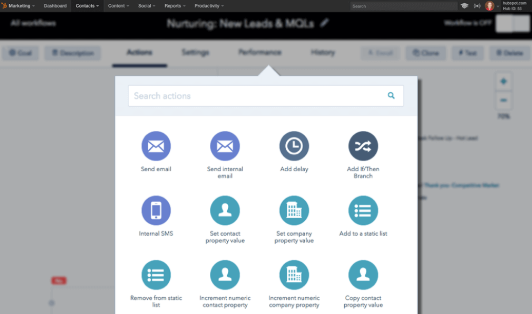 Source: HubSpot
Source: HubSpot
Their system also allows you to set up internal notifications for your team, letting them know when a contact takes a specific action.
Connect All Channels
The beauty of HubSpot’s workflow feature is that it allows you to seamlessly connect all channels together to create a consistent multi-channel experience for your customers.
The actions that they take on your website could influence the emails they receive, landing pages they view, sales reps they interact with, or personalized attention that they receive.
Companies that do not utilize automation find it hard to track the actions that their users take and acknowledge those actions through other channels. The result is that the experience does not end up feeling personalized for the prospect.
They feel like you are missing something and not truly up to date with their engagement with your brand.
The Future of Marketing
We are moving toward an omnichannel future, where brands can engage with prospects across a range of different channels with perfect knowledge of how those prospects have engaged with the brand in the past.
Marketing automation allows you to better understand your customers, speak to their biggest needs, and develop more personalized customer experiences.
Here at RiseFuel, we specialize in designing and executing marketing automation campaigns for our customers and clients.



